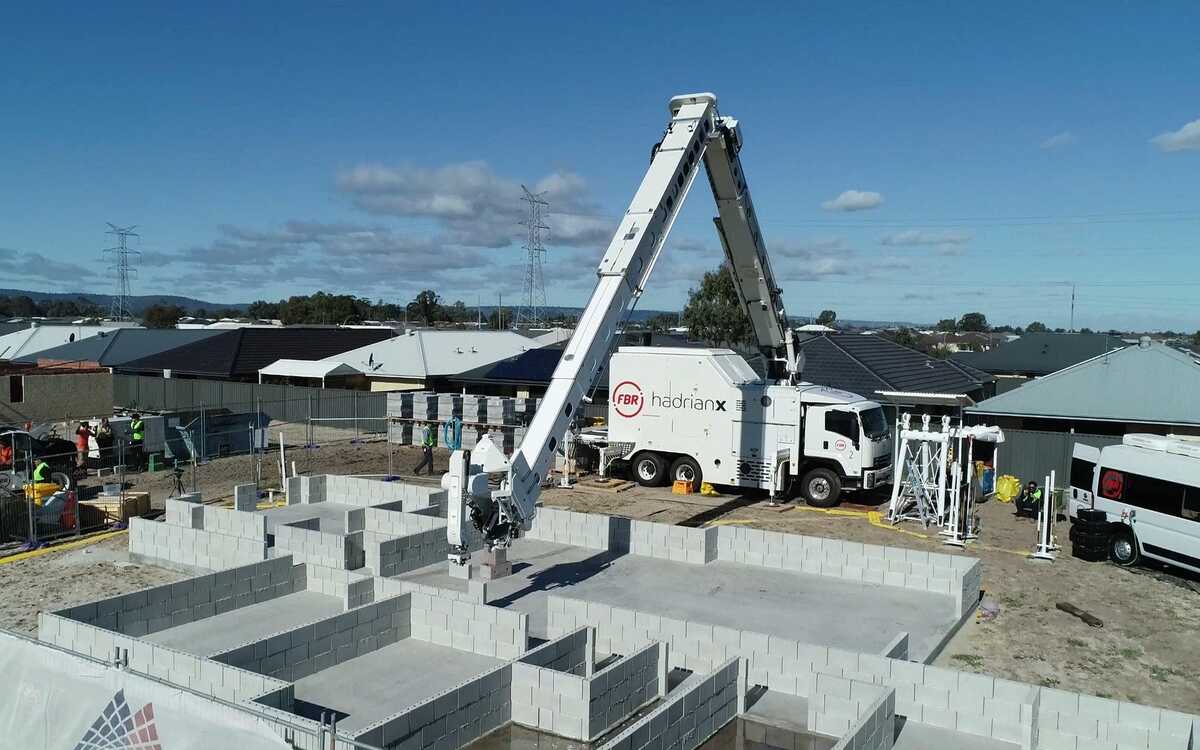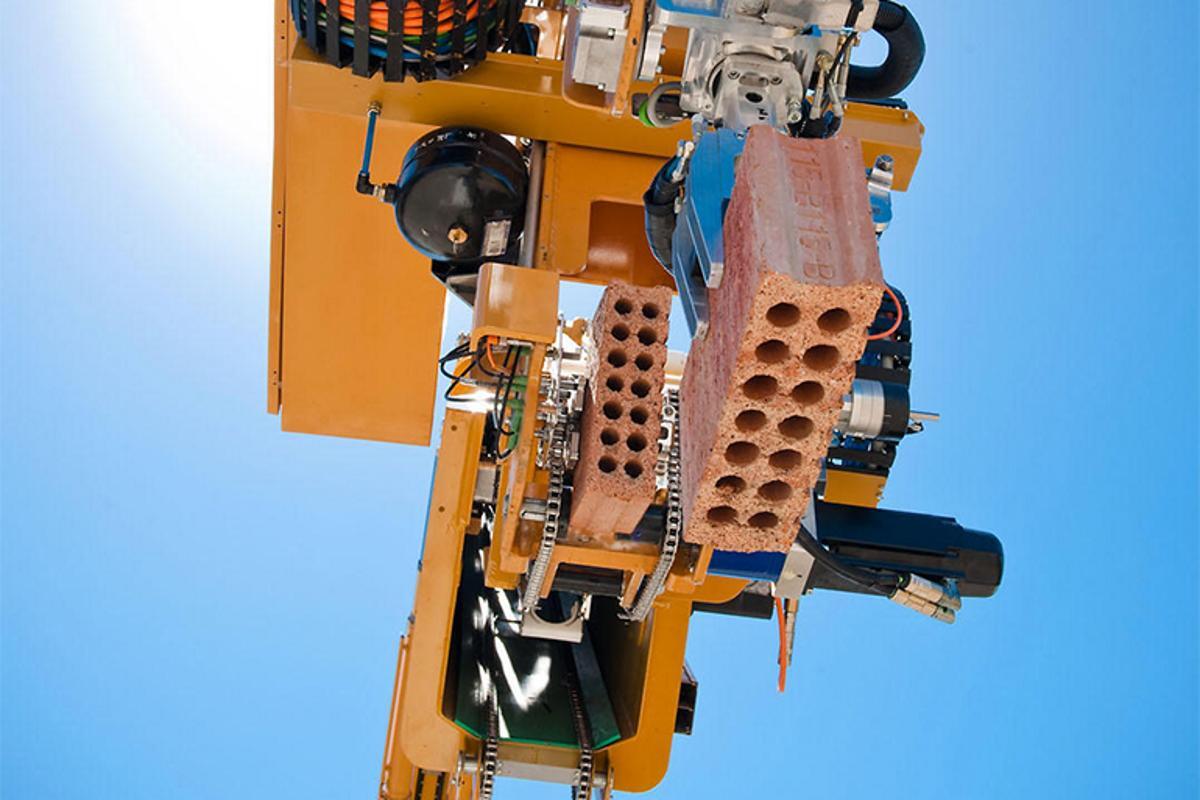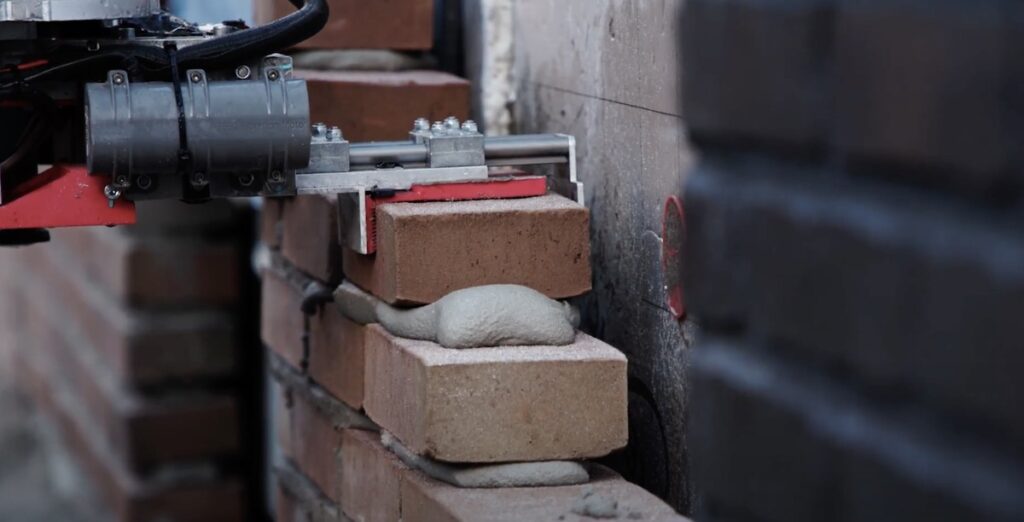Numerous industries have been transformed by robots, and the construction industry is no exception. Construction organizations are increasingly utilizing bricklaying robots’ ability to enhance and speed the building process, thanks to advancements in robotics.
One of the earliest building materials is brick, which dates to 3500 BC for the first kiln-fired blocks and 7000 BC for sun-dried varieties. Unfortunately, not much progress has been made in the traditional bricklaying procedure, which consists of spreading mortar, placing a brick, and using a trowel to smooth away any excess mortar.
Furthermore, one of the biggest issues facing the construction sector is low productivity, and worker productivity in particular has been falling for decades. Finding skilled labor has become increasingly challenging, particularly regarding masons and bricklayers. A National Association of Home Builders survey found that over two-thirds of bricklaying firms have trouble finding competent laborers.
Bricklaying robots are beginning to appear in the construction industry due to the shift to Industry 4.0. Furthermore, it is not surprising that inventors are looking to robotics to assist close the skilled trade gap given the global labor shortages. The Hadrian X bricklaying robots from FBR in Australia and the SAM100 robot from Construction Robotics in the US are two of the most talked about construction robots. This is how these two construction robots disrupt one of the most established sectors of the building.
Table of Contents
What is Robotization in the Construction Sector?
Robotization is the process of having machines carry out human-previously performed duties. These devices are known as robots. The actions can be automatically regulated, are programmable, and frequently repeat.
In the construction industry, there are many different kinds of robots, including the previously mentioned drones and bricklaying robots, as well as autonomous excavators and 3D printers. We can use the devices for various tasks because of their versatility. For instance, we can utilize a drone to capture a picture for a client or to assess the project’s safety or progress.
Suggested articles to read: The Role of Climbing and Inspection Robots in Construction Safety; 2024 Guide
The Rise of Bricklaying Robots
Bricklaying robots sometimes referred to as construction robots, have become more well-known because of their remarkable precision in carrying out repetitive operations. They can precisely navigate and assess the construction site thanks to their sophisticated algorithms and computer vision skills.
Features:
- Sophisticated algorithms and computer vision technologies for accurate analysis and navigation.
- Integrated safety features to guard against mishaps and guarantee worker security.
- Capacity to manage a range of brick kinds and sizes, including asymmetrical designs.
- Programming possibilities that can be customized to meet various building requirements.
- Quick and easy building technique that cuts down on construction time by a large margin.
- Integration for a smooth workflow with current building tools and procedures.
Bricklaying robots automation helps to improve construction accuracy by resolving typical problems including human error, uneven mortar application, and uneven brick placement.
Suggested article to read: The Role of 3D Printing Robots in Construction; 2024 Guide
The Evolution of Bricklaying Robots
British Pathé posted the film Motor Mason after discovering it again in its newsreel collection in 2014. A mechanized bricklayer known as Motor Mason was created as early as the middle of the 1960s. The people saw it as the answer to the housing crisis as it could lay bricks five to ten times faster than the traditional approach.
Installed on a train running parallel to a wall, Motor Mason was designed to rapidly install individual brick blocks after dropping mortar. A few years later, Motor Mason abruptly disappeared from the building sector, leaving a mystery in its wake.
The first contemporary bricklaying robot, called SAM100 (Semi-Automated Mason), was unveiled by Construction Robotics in 2015 during the World of Concrete event. SAM100 triples to five times productivity; yet, societal worries about worker safety and quality of labor prevented its physical adoption.
The automated bricklaying device known as Hadrian X was introduced by Fastbrick Robotics, an Australian business, a few years after it was first manufactured. This robot has various new features and is highly advanced.

Advantages of Bricklaying Robots
In contrast to traditional bricklayers, bricklaying robots have several perks that make them a desirable option for construction projects.
1. Improved Accuracy and Precision
Bricklaying robots are designed to adhere to exacting guidelines, guaranteeing reliable and precise brick positioning. Throughout the construction process, they can ensure accuracy by utilizing their sophisticated sensors and computer vision to assess the surrounding environment and rectify any mistakes.
2. Enhanced Efficiency and Productivity
Bricklaying robots are far more efficient than human laborers in completing tasks because they automate the bricklaying process. They put in endless hours without becoming tired or taking breaks, which boosts output and speeds up project completion. According to studies, these robots can lay bricks three times as quickly as humans, which significantly cuts down on the amount of time needed for construction.
3. Savings on Costs
Labor costs for building organizations can be drastically decreased by using bricklaying robots. These robots can complete the task that would normally take several bricklayers, saving a significant amount of money on wages and related costs. Furthermore, since projects can be finished faster, lowering overhead expenses, a shorter construction period also results in cost savings.
4. Enhanced Security for Workers
Construction sites carry a risk of accidents and injuries, making them dangerous places to be. Employing bricklaying robots allows businesses to reduce these risks and put worker safety first. These devices are built with safety mechanisms and procedures to reduce mishaps and provide a more secure working environment for employees.
Suggested article to read: Top 7 Robotic Welding and Fabrication Types in Construction (2024)
Disadvantages of Bricklaying Robots
- Robotic devices are expensive.
- To operate a machine effectively, one must have the necessary training.
- The machine’s alignment and on-site installation take a lot of time.
- Fuel is necessary for the robotic machine to operate, which has an impact on the environment.
Since the invention of Motor Mason and other automated bricklaying robots, technology has advanced significantly. These days, CAD and data tracking technology are integrated into bricklaying equipment to create more sustainable, safe, and productive structures than ever before. As masonry and construction automation continues to advance and become more prevalent, we should anticipate further changes in these fields.
Bricklaying Robots
There are two types of bricklaying robots called Semi-Automated Masonry (SAM) System and Hadrian X:
1. Semi-Automated Masonry (SAM) System
The SAM System was created by Construction Robotics to collaborate with a mason to lower expenses, boost output, and improve the caliber of work. By removing the need for labor-intensive brick lifting, mortar application, and brick placement, the technology removes these steps. The mason is in charge of making sure the bricks are placed precisely, clearing away extra mortar, and making sure the job is finished correctly all around.
To increase efficiency and safety on the construction site, Construction Robotics also manufactures the MULE (Material Unit Lift Enhancer). This device helps lift and put heavy materials. Robots from SAM and MULE have been deployed on several projects, ranging from offices and hotels to retail establishments and academic buildings.
Suggested article to read: What is Robotic Material Handling? 2024 Guide
2. Hadrian X
Hadrian X, a bricklaying robot prototype by Fastbrick Robotics, can lay 1,000 bricks in an hour and construct a whole house in two days, including doors, windows, and plumbing and electrical conduits.

The Transformative Potential of Bricklaying Robots
One of the most arduous, traditional trades in building is made more efficient, customizable, and sustainable with robotic systems like Hadrian X and SAM.
1. Unmatched Productivity
A bricklayer can lay between 300 and 500 bricks in a long day, whereas SAM100 helps reach a daily production of up to 3000 bricks. Hadrian X doubles production over SAM by working at a rate faster than the latter. He does this by placing more than 1,000 bricks in an hour on his own. Their continuous operation without rest periods, weariness, or distractions confirms additional benefits.
2. Consistent Quality and Customization
Brickwork quality is inherently variable due to human variances in mortar consistency, placement, alignment, and levelness. Bricklaying robots, on the other hand, can put each brick in the intended layout with sub-millimeter accuracy thanks to integrated sensors and software analytics, guaranteeing structural integrity and dimensional uniformity.
The Yorkshire-based construction automation company’s automated brick-laying robot (ABLR) guarantees precise brick placement, decreasing building errors and the need for manual corrections. Through synchronized material arrivals with QR codes, the bricklaying robots’ data is integrated into project managers’ material requirements planning (MRP) systems, optimizing scheduling and reducing on-site waste.
Greater customization and aesthetic flexibility to satisfy architectural requirements across brick forms, bonding patterns, texturing, and colors are made possible by this precision, which is crucial in the transition to mass-customized housing.
Suggested article to read: Robotic Excavators and Diggers in Construction Automation
3. Sustainability
Exact material amount verification at the software level reduces wasteful brick overordering. For instance, the mortar application efficiency of Ballast Nedam’s bricklaying robot is impressive—it uses only 455 grams per brick as opposed to the 1,000 grams that hand bricklayers typically use. Significant material savings and environmental advantages result from this strategy.
By replacing ordinary mortar with specialized building adhesives that offer four to five times greater strength and reduce carbon emissions, Hadrian X accelerates the sustainability of construction as a whole.
Bricklaying robots appear to be a suitable way to sustainably build faster, more accurate, and more customizable residential and commercial structures through transformational technology, as global urbanization drives up housing demand versus labor shortages in the construction industry.
4. Improved Productivity and Time Efficiency
Bricklaying has always been a physically demanding, labor-intensive, and time-consuming job. On the other hand, walls and other buildings can be quickly built by bricklaying robots with unmatched accuracy and speed. Bricklaying jobs that would often take weeks or even months to complete can now be completed in a matter of days, if not hours, thanks to task automation.
Principal benefits:
- Considerably shorter construction schedules
- Improved capacity for project management
- A rise in overall output
- Capacity to fulfill rigorous deadlines more effectively
Suggested article to read: What are Demolition Robots in Construction? 2024 Guide
5. Precision and Accuracy
Bricklaying robots can lay bricks with the highest precision because they are outfitted with sophisticated sensors and algorithms. These devices can apply the exact amount of mortar and arrange each block at the ideal angle every time, guaranteeing a degree of accuracy that can be difficult to accomplish by hand.
Principal benefits:
- Improved consistency and quality in the arrangement of bricks
- Decrease in rework and human error
- Enhanced structural soundness of built structures
- Better visual appeal as a result of accurate alignments
6. Cost Savings and Cost Predictability
Over time, using bricklaying robots can result in significant cost reductions. Even though the initial outlay might seem high, the effectiveness and speed of these devices save labor costs as well as project-related expenses. Furthermore, using robotic bricklayers results in more predictable costs because the robots work continuously without the need for overtime or breaks.
Principal benefits:
- Lower labor expenses as a result of less worker demands
- Reduced quantity of materials lost
- Increased project budgeting and cost predictability
- Optimum use and distribution of resources
Suggested article to read: Cost Overruns in Construction Projects | Construction Cost Estimating
7. Enhanced Safety Measures
Projects involving construction are inherently risky. Bricklaying may greatly reduce the risks involved with manual labor by using bricklaying robots. Because these equipment are built to function within predetermined safety limitations, there is little chance of accidents or injuries occurring on the job site.
Principal benefits:
- Decreased likelihood of mishaps and occupational injuries
- Improved welfare and safety for workers
- Enhanced compliance with strict safety regulations
Suggested article to read: Construction Site Safety: Comprehensive Guide 2024
8. Job Creation and Reskilling Opportunities
It’s crucial to remember that while the advent of bricklaying robots may cause some to worry about job loss, human labor is still needed in some capacities. Rather, they can supplement and assist the labor force, thereby releasing significant time that can be allocated to more intricate assignments. The emergence of this technology also calls for chances for reskilling, enabling employees to adapt and gain expertise in managing and repairing these self-governing systems.
Principal benefits:
- The creation of new positions centered on robotics maintenance and operations
- Opportunities for retraining and upskilling construction workers
- Enhanced productivity and efficacy of manual labor
- Freedom to concentrate on more advanced building tasks

Will Robots Eventually Replace Our Coworkers?
Let’s be clear about one thing: no, our coworkers are priceless. However, robots are incredibly productive; bricklaying robots with a skilled operator may complete as much work as three bricklayers. Our staff are supported by the robots with such efficiency. It keeps our limited supply of bricklayers from being physically overworked in the competitive job market of today.
This innovation makes it possible for humans and machines to work together. As an illustration, the robot plotter simplifies work on the A24 Blankenburg link by drilling holes and laying down steering lines on its own. Additionally, our colleagues take measurements faster now that they have the drone.
Conclusion
Because of the benefits it offers, bricklaying robots have become incredibly popular in the construction sector in recent years. Numerous prospects arise from the building industry’s digitalization. not just for ourselves but also for our customers. By leveraging innovation and digitalization, we can involve our clients in the building process.
We can close the labor gap, boost productivity and quality, increase efficiency, and attract new people by investing in digitalization. We think there is still much work to be done in the digital transformation. We are integrating digitalization into our processes as a result. We are learning and experiencing through pilots, and then we may put the knowledge and experience to use.
While it’s unlikely that robots will ever fully replace human labor in the construction sector, there are plenty of ways they may be utilized to speed up, improve safety, simplify, and reduce labor-intensive tasks on the job site.
The most likely scenario is that human workers will employ robots to supplement their labor, increase productivity, and keep them safer. Given the current capabilities of robots and the developing labor scarcity, it seems likely that robots will take over some of the more routine and menial activities, freeing up human workers to concentrate on other elements of their jobs.
Suggested article for reading:
Smart Building Technology; 2024 Guide
Futuristic Construction; Everything You need to know in 2024
Resources:
Ballast-Nedam | ConstructConnect | TheConstructor | UtilitiesOne | AzoroBotics | Linkedin | Reddit | Procore | SpiceWorks
For all the pictures: Freepik



